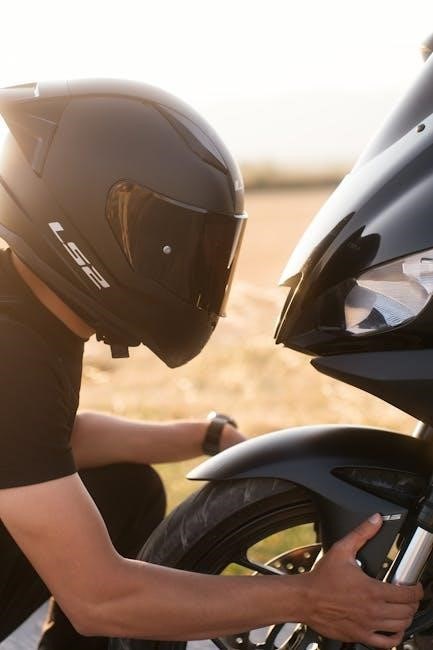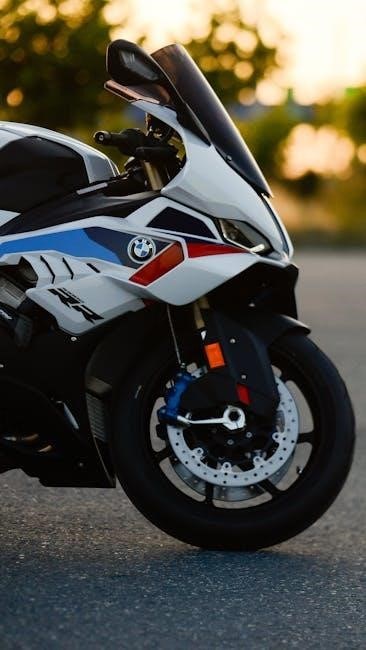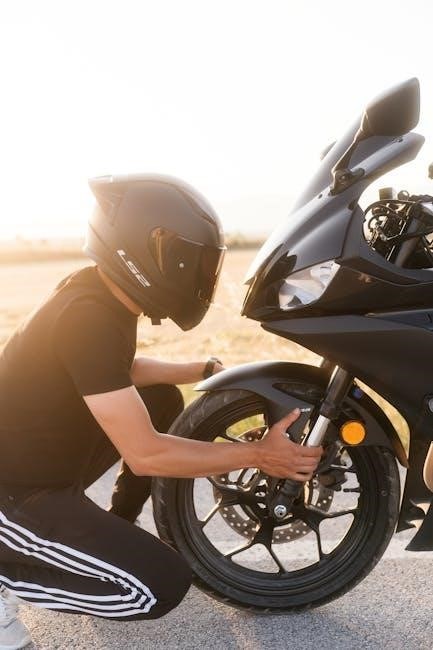Welcome to our comprehensive bike guide! Discover essential information on choosing the right bike, maintenance, safety, and riding techniques for every cyclist.
Understanding the Importance of Choosing the Right Bike
Choosing the right bike is crucial for ensuring an enjoyable and efficient riding experience. With so many types of bikes available, each designed for specific purposes, selecting the wrong one can lead to discomfort, inefficiency, or even frustration. Whether you’re cruising on paved roads, tackling off-road trails, or commuting through the city, the right bike will enhance performance and satisfaction. Factors such as riding frequency, terrain, and personal fit play a significant role in determining the best option. A bike that matches your needs ensures better control, safety, and overall enjoyment. Investing time in understanding your preferences and the bike’s features can make a significant difference in your cycling journey. Always consider your lifestyle and riding goals to make an informed decision.
Types of Bikes
From road bikes to mountain, hybrid, gravel, and electric bikes, each type is designed for specific terrains and riding styles, catering to diverse cycling needs and preferences.
Road Bikes
Road bikes are designed for speed and efficiency on paved surfaces, making them ideal for racing, long-distance rides, and fitness training. They typically feature lightweight frames, narrow tires, and multiple gears to optimize performance. The riding position is more aerodynamic, with drop handlebars allowing for better control and speed. Road bikes are perfect for cyclists who prioritize velocity and endurance on smooth terrain. However, they are less suitable for rough or off-road conditions due to their thin tires and rigid frames. With various sub-types like endurance, racing, and gravel bikes, road bikes cater to a wide range of riding preferences and goals.
Mountain Bikes
Mountain bikes are built for off-road adventures, offering durability and stability on rough terrain. They feature sturdy frames, wide tires with aggressive tread, and suspension systems to absorb shocks from rocks and bumps. These bikes are ideal for trails, downhill routes, and challenging landscapes. Mountain bikes come in sub-types like hardtail (front suspension only) and full-suspension (both front and rear), catering to different riding styles and preferences. They provide excellent control and traction, making them perfect for riders who enjoy exploring nature and pushing their limits on demanding paths. Whether climbing steep hills or descending technical descents, mountain bikes deliver a thrilling and rugged cycling experience.
Hybrid Bikes
Hybrid bikes offer a versatile combination of road and mountain bike features, making them ideal for diverse riding conditions. They feature a comfortable upright riding position, medium-width tires for stability, and a lightweight frame designed for efficiency. These bikes excel on paved roads, bike paths, and light gravel or dirt trails, making them perfect for commuting, fitness rides, or casual adventures. Hybrid bikes often include mounts for racks and fenders, allowing customization for practicality or touring. Their adaptability and ease of handling make them a great choice for riders seeking a balance between performance and comfort on various terrains. Whether cruising around the city or exploring light off-road routes, hybrid bikes provide a reliable and enjoyable experience.
Gravel Bikes
Gravel bikes are designed for mixed-terrain riding, blending the speed of road bikes with the durability of mountain bikes. Featuring wider tires with tread patterns for better grip on loose surfaces, gravel bikes are built to handle dirt roads, gravel paths, and light trails. Their relaxed frame geometry provides stability and comfort over long distances, while drop handlebars allow for multiple hand positions and aerodynamic efficiency. Ideal for adventure riding, bikepacking, or endurance rides, gravel bikes are versatile and capable of tackling a variety of surfaces. Their robust construction and adaptability make them a favorite for riders seeking freedom and excitement on both paved and unpaved routes.
Electric Bikes
Electric bikes, or e-bikes, are a modern innovation combining traditional cycling with electric power assistance. Designed to make riding easier and more accessible, e-bikes feature motors and battery systems that assist pedaling, helping riders cover longer distances with less effort. They are ideal for commuting, running errands, or exploring hilly terrains without fatigue. E-bikes come in various styles, including road, mountain, and hybrid models, offering versatility for different riding needs. With a range of price options—from affordable models starting at $500 to high-end bikes costing $5,000 or more—electric bikes cater to a wide audience. Their eco-friendly nature and cost-effectiveness make them a popular choice for both casual riders and enthusiasts seeking convenience and efficiency.

Choosing the Right Bike for Your Needs
Electric bikes, or e-bikes, combine traditional cycling with electric power assistance, offering effortless pedaling and extended range. They are perfect for commuting, errands, or challenging terrains, catering to all skill levels. With versatile designs mirroring road, mountain, and hybrid bikes, e-bikes provide unmatched convenience. Affordable options start at $500, while advanced models exceed $5,000, ensuring a fit for every budget and preference. Their eco-friendly and cost-effective nature makes them a popular choice for both casual riders and enthusiasts seeking efficiency and comfort.
Factors to Consider When Selecting a Bike
When choosing a bike, consider your riding purpose, terrain, and budget. Determine if you’ll ride on roads, trails, or a mix of both. Think about how often and how far you plan to ride. Assess your budget, as bikes vary widely in price. Consider the number of gears needed for your terrain and whether accessories like racks or fenders are necessary. Bike fit is crucial for comfort and efficiency. Test ride different models to ensure proper sizing and comfort. Reflect on your lifestyle—will the bike be for commuting, fitness, or leisure? Additionally, consider maintenance costs and the bike’s durability for long-term use. These factors will guide you to the perfect bike for your needs.
Pros and Cons of Each Bike Type
Each bike type offers unique advantages and drawbacks. Road bikes excel in speed and efficiency on paved roads but lack versatility for off-road terrains. Mountain bikes are durable and ideal for rough trails but are heavier and less efficient on smooth surfaces. Hybrid bikes combine comfort and practicality, making them great for casual rides, though they may lack specialization. Gravel bikes offer a balance of speed and off-road capability but can be less optimized for extreme conditions. Electric bikes provide convenience and ease, especially for longer distances, but are generally more expensive and heavier. Understanding these pros and cons helps cyclists choose a bike that aligns with their specific needs and preferences.

Bike Maintenance and Care
Regular cleaning, lubricating chains, and checking tire pressure are essential for prolonging bike life. Inspect brakes and gears regularly to ensure safety and optimal performance.
Essential Maintenance Tips for Prolonging Bike Life
Regular maintenance is crucial to ensure your bike performs optimally and lasts longer. Start by cleaning the frame, wheels, and chain frequently to remove dirt and grime. Lubricate the chain every 100-200 miles to prevent rust and wear. Check tire pressure before each ride and inflate to the recommended level for better efficiency and safety. Inspect brake pads and replace them when worn thin to maintain reliable stopping power. Additionally, tighten bolts and screws periodically to secure components. Store your bike in a dry place to avoid rust and protect it from extreme temperatures. By following these simple steps, you can extend your bike’s lifespan and enjoy a smoother riding experience.
Advanced Maintenance Techniques for Optimal Performance
For optimal performance, consider advanced maintenance techniques. Regularly clean and lubricate your cassette and chainrings to prevent wear. Adjust the derailleur limits to ensure precise gear shifting. Inspect and replace the brake cables and housing if frayed. Bleed hydraulic brakes annually to maintain consistent stopping power. Clean and repack wheel bearings and headset bearings with high-quality grease. Replace the bottom bracket if it shows signs of wear. Use a torque wrench to ensure all bolts are tightened to the manufacturer’s specifications. Finally, overhaul your suspension forks and shocks according to the manufacturer’s schedule. These steps will enhance your bike’s efficiency, safety, and overall performance, ensuring it runs like new for years to come.

Bike Safety and Accessories
Enhance your cycling experience with essential safety gear and practical accessories. Helmets, lights, and reflectors ensure visibility and protection. Consider locks, water bottles, and panniers for convenience and security.
Must-Have Safety Gear for Every Rider
Safety should always be your top priority when cycling. A properly fitted helmet is essential to protect your head in case of a fall. Front and rear lights improve visibility, especially at dawn, dusk, or night. Reflectors on your bike or clothing ensure drivers can see you from a distance. Gloves provide grip, comfort, and protection for your hands; Knee and elbow pads are recommended for off-road or high-risk riding. Additionally, consider a bike lock for security and a small toolkit or puncture kit for emergencies. Always wear bright, reflective clothing to increase your visibility. Regularly check and maintain your safety gear to ensure it functions properly. Stay safe and visible on the road!
Recommended Accessories to Enhance Your Riding Experience
Enhance your cycling experience with practical and stylish accessories. A comfortable saddle or seat cover can improve your ride quality, while padded cycling shorts reduce discomfort on long journeys. Fenders protect your clothes from mud and water, making them a great addition for wet conditions. A water bottle cage and bottle are essential for staying hydrated. Handlebar bags or racks allow you to carry essentials like snacks, tools, or extra gear. A bike computer or GPS device helps track your performance metrics, such as speed and distance. Additionally, lights and reflectors enhance visibility, while a floor pump or mini pump ensures your tires stay inflated. For added convenience, consider a phone mount or bike lubrication kit to keep your bike running smoothly. These accessories can elevate your riding comfort and performance.

Bike Riding Tips and Techniques
Mastery of balance, smooth braking, and maintaining steady speed is crucial. Proper body positioning enhances efficiency, while gear selection optimizes performance on various terrains for a seamless ride.
Mastering Basic Riding Skills
Mastering basic riding skills is essential for every cyclist, regardless of experience. Start by focusing on balance and stability, keeping your eyes forward and body centered over the bike. Practice braking smoothly, using both brakes evenly to avoid skidding. Learn to accelerate gradually, shifting gears seamlessly to maintain momentum. Turning effectively requires leaning your body and steering confidently. Always signal your intentions to ensure safety. Familiarize yourself with basic bike handling techniques, such as navigating obstacles and maintaining control on varying terrain. Regular practice in a safe, open area will build your confidence and refine your skills. Remember, mastery takes time, so be patient and enjoy the process of improving your riding abilities.
Advanced Riding Techniques for Different Terrains
Advanced riding techniques vary depending on the terrain. On road bikes, focus on efficient pedaling, drafting, and maintaining a steady cadence. For mountain bikes, master line choice, obstacle navigation, and controlled descents. Gravel bikes require balancing speed and stability on loose surfaces. When tackling trails, practice cornering, braking, and maneuvering around tight spaces. Adjust your gear ratios for climbs and descents, and use body weight to maintain control. On technical descents, keep your center of gravity low and shift weight backward. For mixed terrain, adapt your riding style to suit the surface, ensuring smooth transitions. Always match your bike type to the terrain for optimal performance and safety.

Bike Trails and Routes
Explore popular bike trails for road, mountain, and gravel bikes, offering scenic routes and challenging terrains. Discover local and international destinations for your next adventure.
Popular Bike Trails for Road Bikes
Discover iconic road bike trails worldwide, offering smooth surfaces and breathtaking views. The Pacific Coast Highway in California and Australia’s Great Ocean Road are favorites among cyclists. These routes provide scenic rides with minimal traffic, ideal for endurance training and leisurely cruises. For European adventures, France’s Route des Cols and Italy’s Strade Bianche deliver challenging yet rewarding experiences. Closer to home, local parks and designated bike paths offer shorter, family-friendly options. Always check trail conditions and plan your route according to skill level and distance preferences. Remember to stay safe, wear appropriate gear, and enjoy the thrill of exploring new territories on two wheels.
Best Off-Road Trails for Mountain Bikes
Explore the world’s most thrilling off-road trails, designed for mountain bikes. Utah’s Moab offers iconic red rock formations and challenging terrain, while Finale Ligure in Italy boasts scenic coastal descents. For technical riders, British Columbia’s Whistler Bike Park is renowned for its demanding trails and adrenaline-pumping features. In New Zealand, Queenstown delivers breathtaking alpine routes. Closer to home, local forests and parks often have hidden gems with varying difficulty levels. Always check trail conditions, wear proper safety gear, and ride within your skill level. These trails promise unforgettable adventures for mountain bikers, whether you’re a beginner or an expert seeking a challenge.

Bike Etiquette and Traffic Rules
Respect traffic rules and other road users. Always use hand signals, stay in designated bike lanes, and follow local regulations to ensure safety and harmony on the road.
Understanding Bike Lanes and Traffic Signals
Respecting bike lanes and traffic signals is crucial for safe cycling. Bike lanes are designated paths for cyclists, providing separation from vehicular traffic. They come in forms like protected lanes (with physical barriers), buffered lanes (with extra space), and shared lanes (marked with symbols). Traffic signals, including traffic lights and stop signs, must be obeyed by cyclists. Always come to a complete stop at red lights and stop signs. Use hand signals to indicate turns, ensuring visibility to drivers and pedestrians. Familiarize yourself with local traffic laws, as they vary by region. Understanding these rules enhances safety for all road users and promotes harmony between cyclists and vehicles.
Etiquette for Sharing the Road with Other Riders and Vehicles
Proper etiquette when sharing the road ensures a safe and respectful environment for all. Always stay alert and be aware of your surroundings. Yield to pedestrians and other cyclists, especially in shared paths. Use hand signals to indicate turns, allowing others to anticipate your actions. Avoid sudden movements that could startle drivers or other cyclists. Maintain a safe distance from vehicles and other riders to prevent collisions. Never weave in and out of lanes or ride against traffic flow. Be mindful of noise levels and avoid startling others. Show mutual respect by staying visible, following traffic rules, and being courteous. By adhering to these guidelines, you contribute to a harmonious and safe road environment for everyone.
